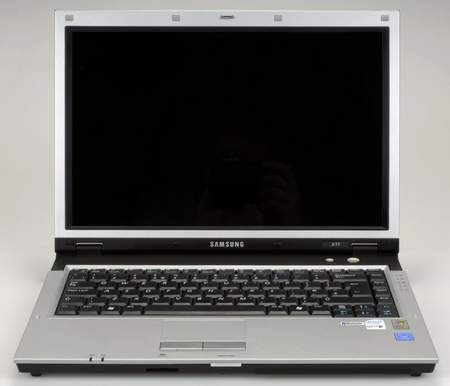Samsung has a reputation for delivering ultraportable notebooks at an aggressive price and the X11 follows a similar theme. At £750 (inc. VAT) it comes with an affordable price tag, especially when you consider it’s running a dual-core processor in the form of the Intel Core Duo T2300 (1.66GHz). While this isn’t the fastest chip on the market, it’ll more than get the job done. The system is shipped with 512MB of memory, which is a little low and we’d suggest getting this bumped up to 1024MB as you’ll really see the difference, especially when running more than one application. That said, we had no problems with the machine, as it handled our daily tasks comfortably. The 80GB hard drive is larger than we were expecting, so will easily handle all your files and programs.
Our quick take
For the asking price, the Samsung X11 is a good all-round machine that is powerful enough for most users, especially if you opt for the memory upgrade, just doubt expect it to last a long time away from mains power.
This notebook is best suited to a student, or someone who needs to make limited notes and then use the machine for long periods once back at their desk. If this sounds like you, you’ll find a cost-effective answer in the X11.

Samsung X11 laptop - 4.0 / 5
| FOR | AGAINST |
|---|---|
|
|
The chassis itself weighs in at 1.8kg, which is ideal for carrying around, as you won’t find it taxing on your shoulder. The styling is neat and tidy, with an angular design, and a silver and black finish. The keyboard has good-sized keys, and a well-judged action makes it easy to type at speed. The coarse, responsive touchpad mirrors the screen’s aspect ratio, and has a scroll bar on the side. Brushed aluminium buttons add a tactile, quality feel to the system.
It’s not all-good news, as this weight is counter-balanced by a less than ideal battery life. On average, we found ourselves looking for a top-up every couple of hours when working even simply word processing tasks, so not the best machine if you want to be truly free of wires.
The screen is a standard 14.1-inch TFT panel, so you won’t find a glossy coating but it is widescreen, so watching DVDs or simply more than one page of a document up on the screen at any one time is easily done. Graphics are an integrated Intel chip, so you won’t be able to play games but it’s more than powerful enough for work related tasks.
Keeping costs down is the use of a standard DVD/CD-RW drive, which isn’t as versatile as a DVD rewriter but you’ll be able to watch DVDs with little trouble. In terms of connectivity, you’ll find Gigabit Ethernet, enabling fast connections to fixed networks. To take advantage of wireless hotspots, an 802.11a/b/g Wi-Fi adapter is built-in. For connecting to external displays, you’ll find S-Video and VGA-out sockets, ideal for presentations. A Bluetooth adapter allows you to transfer files wirelessly, and there’s also a 6-in-1 card reader.
To recap
This Core Duo notebook is a mixed bag of components better suited to the student than as a family machine
